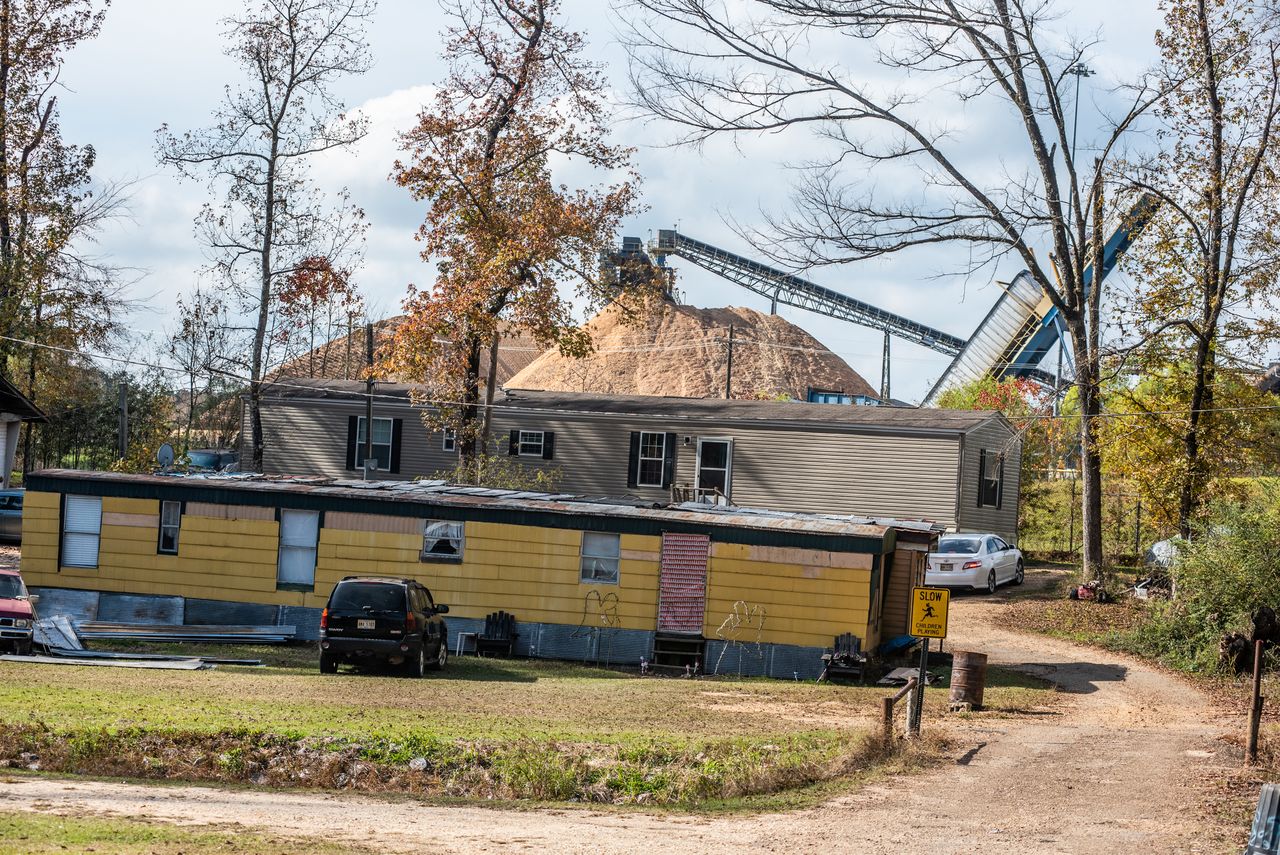GLOSTER, Miss. — Carmella Wren-Causey knew something was wrong as soon as she returned to her hometown last year, a place where she’d slept on her grandmother’s screened porch to smell the sweet, crisp fragrance of longleaf pines on summer evenings. Though it had been years since Wren-Causey, 60, had smoked her last cigarette, she was having a harder and harder time breathing.
Within months of moving into a small, prefabricated home on property her great-grandparents first bought nearly a century ago, even just tending her garden left her so dizzy she felt faint. Dragging the garbage the short walk up to the road required at least three breaks to catch her breath. Hoisting herself into her Nissan pickup became a process: one leg, a gargled inhale, a lean, then the other leg. She could barely sleep at night and recently started going to bed hooked up to an oxygen tank.
She had struggled with breathing problems before. But now her doctor had to increase her medication. She joked that her inhaler had become her best friend. When her two beloved spunky pugs Rayray and Tiny – her “babies” she took everywhere – died suddenly, just three weeks apart, it became a little too true. The dogs had also struggled to breathe, wheezing with anguish shortly before dying.
“The truth is, you got people around here that stay sick. You got people around here that has to use asthma pumps that didn’t have respiratory problems before,” Wren-Causey said, weeping.
“I go to bed, my lungs hurt,” she said. “I wake up, my lungs hurt. It’s horrible.”
Wren-Causey lives less than a mile from the mill where the British utility giant Drax turns towering tree trunks into wood pellets the size of vitamin capsules, which are then shipped to the United Kingdom to be burned in power plants. When the company opened the mill here eight years ago, tiny Gloster, with its shrinking population of about 800, became part of the $52 billion global supply chain for wood-fired electricity. The industry is on pace to grow 6% or more per year this decade.
To some lifelong residents of Gloster, the Drax plant was a godsend, the first sign of life since 2002, when the lumber mill that was once the town’s economic heart closed and left a once-thriving main street a ghost town.
To others, the facility was a curse. Feeding it meant reducing local forests that once teemed with deer and squirrels to plantations of wimpy saplings. And many in this mostly Black community, where median incomes barely hit $10,000 a year, say it has polluted the air with disease-causing gases called volatile organic compounds without delivering them promised new jobs.

Perhaps counterintuitively, the push to build the Drax mill and feed it with Southern forests is the product of policies meant to stop global warming.
European Union and British regulators decided that emissions from wood-fired power plants would not count the same as pollution from fossil fuel generators, making companies like Drax eligible for billions in subsidies for green energy. The firm received nearly $1.1 billion in clean power subsidies last year alone.
Seeing how quickly the industry grew off government funding meant to cut emissions, scientists and activists mobilized to stop its expansion, complaining that the whole thing was built off faulty premises: Trees regrow, but it takes decades to centuries, and burning wood can release more planet-heating gases than coal because you need much more to generate the same amount of power. But it was too late: A multi-billion-dollar industry had already put down roots and cultivated powerful political allies.
In the U.S., federal incentives to build wood-burning power plants are much smaller, and their share of the country’s electricity generation has declined over the past seven years. But states, particularly in the South, have lavished tax breaks on firms that harvest and process wood to send it across the ocean. And the industry has boosters inside the Biden administration such as Agriculture Secretary Tom Vilsack and a spurious but catchy new sales pitch promising that new technologies will render it capable of pulling more carbon from the atmosphere than it emits.
“When the industry claims it’s carbon neutral, it’s saying we recognize there’s CO2 coming out of the smokestacks, but it was instantaneously offset by CO2 uptake somewhere else, and therefore it’s not in the atmosphere,” said Mary Booth, an ecologist and founder of the Partnership for Policy Integrity, an environmental research and advocacy nonprofit. “But that’s not what’s happening. If you burn a tree, it emits carbon right away. And if you grow a tree, it takes up carbon over a long time.”
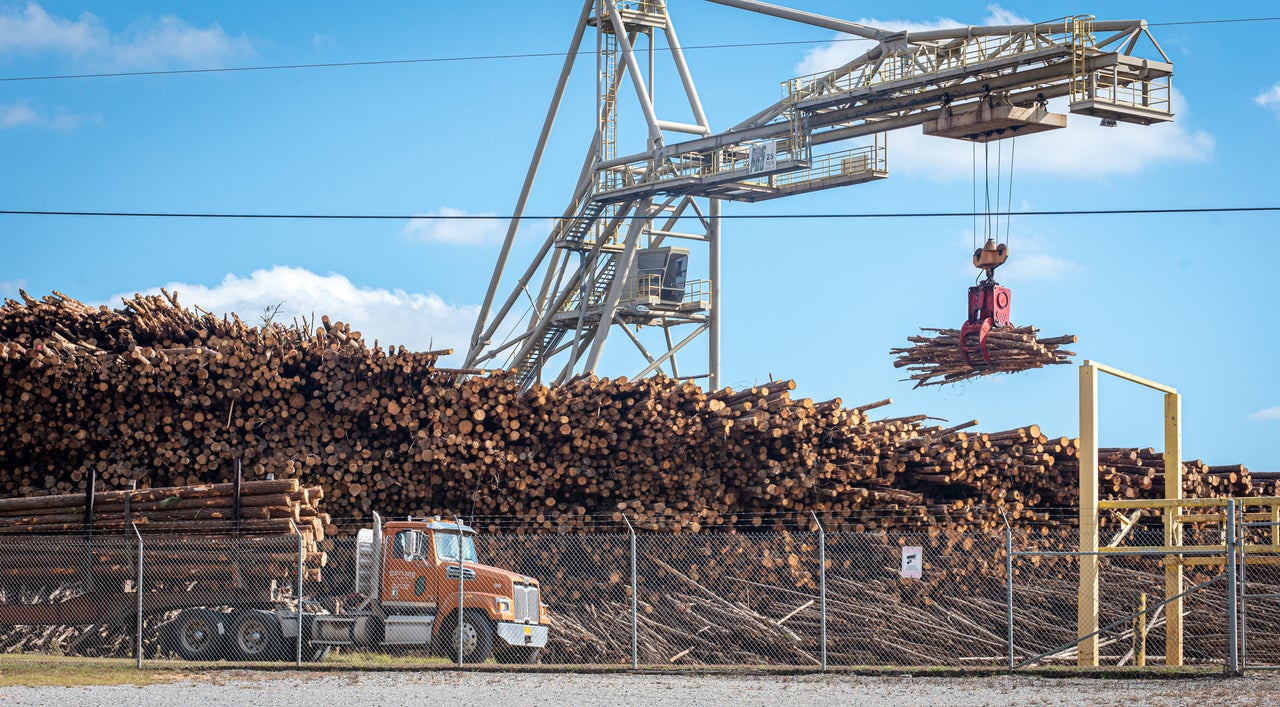
Could Or Should Wood Be A Climate Solution?
Burning plant matter for energy predates even Homo sapiens, as studies show earlier species of hominids used it for fire. But the modern biomass industry, which burns plants or plant-based synthetic fuels to power generators and produce power, did not gain prominence until the 1970s, as the oil crisis spurred interest in alternatives to fossil fuels.
The wood-fired power sector really started booming in the second decade of the 21st century. The United Nations’ Intergovernmental Panel on Climate Change had, for decades, advised countries to attribute carbon from chopping down trees to the land-use sector, not energy, to avoid double counting. That meant countries didn’t have to report the emissions from wood-burning power plants as part of their overall carbon footprint.
There were various justifications for doing so that have shifted wildly over the years. But one of the more straightforward, if perhaps too ecologically simplistic, explanations was this: Scrap wood or dead trees left to rot would emit carbon anyway, so turning that biomass into fuel that could supplant fossil fuels would balance out the atmospheric pollution ledger.
In reality, it set the stage for creating an accounting convention that would allow some of the richest nations that contributed the most to the cumulative carbon mess in the atmosphere to boost their struggling timber industries and inflate their green bona fides.
The methodology reflected the long-standing view in Europe, where wood-burning furnaces and stoves are common, that wood was a renewable resource. So when the European Union adopted its 2009 Renewable Energy Directive — a plan to reach 20% renewable energy by 2020 to help the bloc adhere to the world’s first climate treaty, the Kyoto Protocol — it followed a long tradition of giving wood-fired power plants the same emissions-free status as wind and solar. As a result, coal-dependent countries like Britain and Germany began heavily subsidizing wood burning.
“If you burn a tree, it emits carbon right away. And if you grow a tree, it takes up carbon over a long time.”
- Mary Booth, ecologist and founder of the Partnership for Policy Integrity
This was despite the fact that burning freshly cut wood chips, which are wet and far less energy-dense than fossil fuels, can emit between 40% and 60% more carbon per megawatt-hour of electricity than coal. Wood pellets like those the Drax plant produces are dried and therefore more efficient, and generate fewer emissions when they’re burned despite spewing more gases where they’re produced.
“Sustainable biomass is renewable because of the closed carbon cycle created when trees grow and take CO2 from the atmosphere. Whether the wood is used for bioenergy or these trees naturally decompose, the same amount of CO2 is released into the atmosphere,” said Ali Lewis, a Drax spokesperson, in a lengthy email. “The cycle remains in balance because the working forests which supply the low-grade wood used for biomass are replanted and these growing trees absorb more carbon.”
The problem, the industry’s critics say, is that cycle’s timeframe. It takes at least 82 years for a biomass plant’s regrown forests to lower that facility’s carbon footprint to that of a coal plant. And that’s the best-case scenario outlined by a peer-reviewed emissions calculator tool created by Natural Resources Canada, a government agency. Even after 100 years, wood-fired electricity could not close the emissions gap with a natural gas plant, the calculator data show.
Yet by the time this became clear enough to build some kind of political momentum, biomass had not only grown into an industrial heavyweight, it had split the traditional green voting bloc in the EU, attracting support from the usually climate-conscious Scandinavians who also have large timber industries.
The reporting metric also allowed Europe to credit its existing wood-burning operations as renewable energy, effectively juicing its green energy numbers to make the continent look much more ecologically balanced than it actually was.
Biomass had an extra appeal that has become a more prominent industry talking point in recent years. Unlike wind and solar, which can operate sporadically, wood-fired plants can run as long as there’s something to burn, providing the reliable baseload electricity we expect from fossil fuels.
The EU embraced wood at the same time the U.S. leaned into the Northeast’s hydraulic fracturing boom and replaced its coal plants with cheap and abundant natural gas. This presented an opportunity for states across the forested South to revive the timber industry, then on the decline, by welcoming companies that would feed Europe’s growing appetite for pellets.
Gloster’s Drax plant became one of the largest pellet mills in the U.S. when it opened eight years ago.
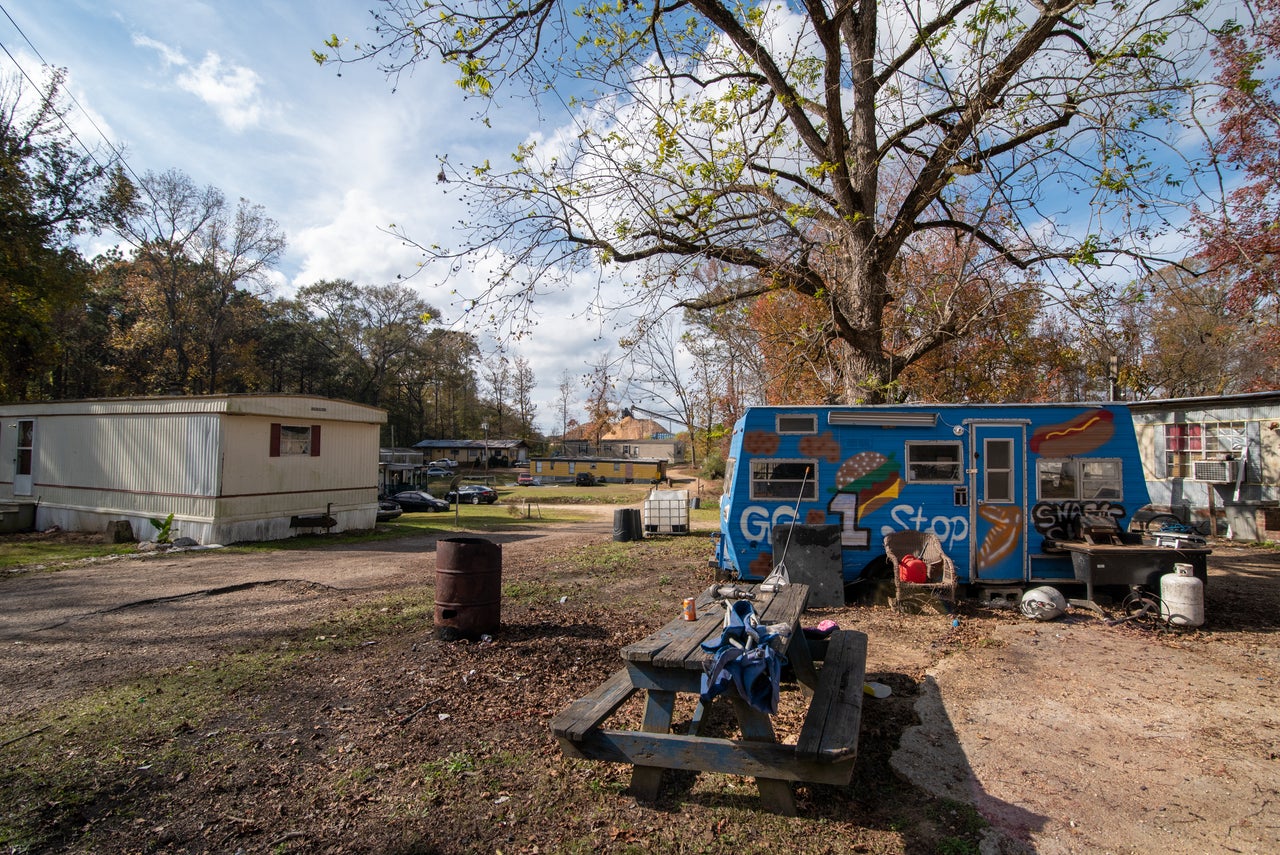
Air You Can Taste
In 2013, when wood pellet exports from the U.S. doubled from the previous year to 3.2 million tons, Drax chopped down the pines and oaks that once covered the hill behind Blackmon Hole, a small Black-owned trailer park five minutes from downtown Gloster.
“I used to go hunting up there,” said Pete, a Blackmon Hole resident who declined to give his last name as he sipped a Bud Lite and tinkered with a new transmission in an old gray Ford Crown Victoria. “Now ain’t nothing coming around with all that noise.”
On that late Wednesday afternoon in early December, the maze of towering metal chutes that make up the mill was clanking and humming, a cacophony occasionally joined by the roar of semi-trucks carrying flatbeds of pine logs. A grayish-white cloud billowed from a smokestack.
Air pollution from wood pellet plants comes from various sources. There’s the exhaust from a steady convoy of trucks. And, perhaps worst of all, the kiln that dries chipped trees to turn them into wood pellets, spewing loads of volatile organic compounds, or VOCs, that contribute to smog and ozone pollution; aggravate asthma and other lung conditions; cause cancer; and trigger itchy eyes and skin. In between, too, there are additional VOCs sent into the air when the hammermills shred trees and the pellets are fully processed.
The wood pellet industry and regulators almost never account for that pollution in permitting, according to a landmark 2018 study by the Environmental Integrity Project, a watchdog group.
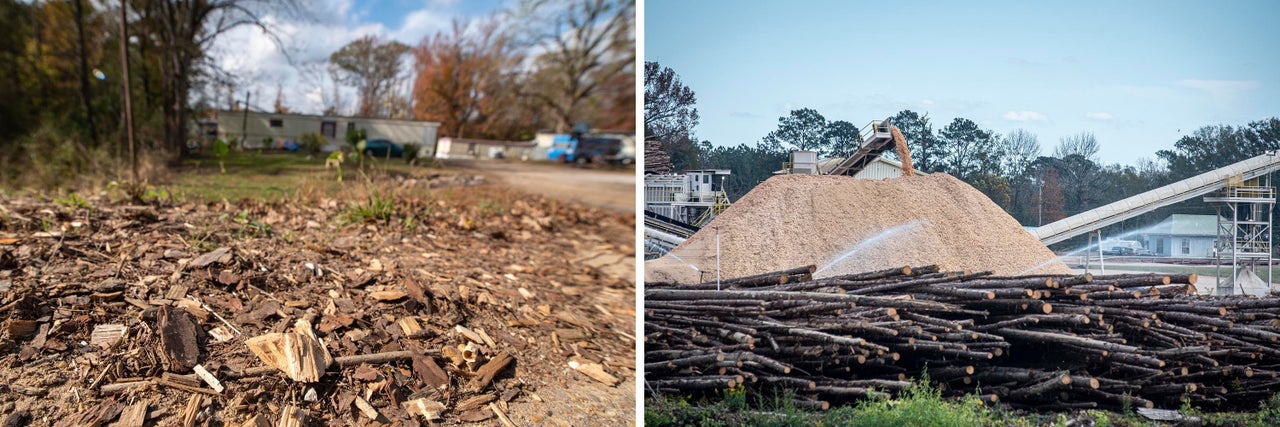
In the middle of the gravel driveway that cuts through Blackmon Hole is a yellow sign that reads: “Slow: Children Playing.” Once school let out, at least half a dozen kids chased each other around the lawn between the trailers.
Heading up the hill toward the chainlink fence between the homes and the Drax facility, the air takes on a sharp, peppery flavor. It stung the inside of my nostrils before the smell even registered. My eyes watered and I sneezed; later on, my lungs felt heavy, like an occasional smoker might feel after a rare cigarette.
Jasmine Jenkins lives at the edge of the park, with her daughters, 8 and 3, and her son, 5.
“They’ve had allergies ever since they were born,” Jenkins, 28, said while standing on the steps of her home one night after returning from work. “One of my kids breaks out in hives every two to three months.”
Several feet away stood her neighbor Shirley Bland, who, after 30 years living here, said she only started finding a daily layer of residue on her car once the plant opened.
“It must be what they put up in the air,” said the 57-year-old grandmother. “I keep feeling out of breath.”
The Environmental Integrity Project report found that Drax’s plant was emitting more than three times as many VOCs as the company was legally permitted to emit.
Last fall, the Mississippi Department of Environmental Quality fined Drax $2.5 million and demanded the company install new catalyzing technology to help disintegrate more of the pollution before it enters the atmosphere. An agency spokesperson sent a link to the fine but did not respond to HuffPost’s questions about whether Drax had fully fulfilled the regulators’ demands.
Drax declined my request to visit the plant but said it installed catalytic oxidizers in Gloster and two plants in Louisiana this past summer.
It was the highest fine any wood-pellet plant in the U.S. has incurred, according to the Dogwood Alliance, a North Carolina-based nonprofit that advocates against expanding the biomass industry. But such penalties are not widely publicized, particularly by the states promoting the industry, making it difficult to confirm. It took months for watchdog groups that track the industry, including Dogwood Alliance, to put out a press release about the fine.
Organizers from the Dogwood Alliance came to Gloster in June to hold a town-hall meeting with residents. Upward of 80 people showed up, many complaining about breathing and skin problems.
The gathering drew backlash from local officials. In a post on Facebook, Mayor Jerry Norwood warned that rabble-rousing could drive Drax out of town and take its purchasing power, which helped offset the cost of water, gas and electricity in Gloster, with it.
“If by some chance a big lawsuit should happen and Drax decides to close [its] gates please be prepared for your utility rates to triple,” Norwood wrote.

The warning seems to have resonated. When organizers Erniko Brown and the Rev. Michael Malcom returned months later, about four people came to their information session, expressing fear about their bills going up.
“It’s bullying,” said Malcom, a pastor and environmental justice advocate in Birmingham, Alabama. “I hate a bully. And that’s what this is.”
The turnout to the activists’ Dec. 3 town hall meeting was higher, with about a little over a dozen attendees. But at least six of them, including the mayor, came to express concerns that the campaign against Drax threatened Gloster’s economic future.
“I’ve been a Gloster resident all my life. I grew up here. And I don’t want my town to go to dirt,” said Cissy Fenn, 68, a former school teacher.
Brandy Hamilton, one of the Dogwood Alliance’s lead organizers, said her group had no intention of shutting down Drax and told Fenn to lower her voice, asking her to be “mindful that everyone has high emotions.”
“You’ve been in Gloster all your life,” she told Fenn, who is white. “I’ve been Black all my life.”
Fenn looked shocked by the implication that racism had anything to do with the Drax plant. Her husband, Reggie Fenn, 67, spoke up: “Look, we all bleed red.”
“We all have things that make us sensitive to things,” Hamilton said.
“It’s not a Black and white issue at all for me,” Cissy Fenn said. “It’s survival for us.”
“It’s survival for everybody,” Hamilton replied.
Doug Iverson, who once ran a mill that turned grain into feed pellets for livestock, asked Hamilton where she was from. She told him Charlotte, North Carolina. He questioned how the air here could be worse than in such a big city.
“You know, I grew up in this little town, and there was always dust around,” he said. “Once a week I had to dust every piece of furniture you could wipe your hand on.”
“I know you’re not dusting the houses over in Blackmon Hole,” Hamilton said.
Once Norwood, the mayor, joined in, the argument quickly devolved into shouting. Reggie Fenn walked out, then Iverson. Brown, pulling rank, asked her colleague Hamilton to leave and cool off.
Jerry White, 75, the president of the local chapter of the National Association for the Advancement of Colored People, said he doesn’t think “race was the main issue,” but hoped Drax would take additional steps to reduce pollution and help those living in Blackmon Hole.
“We can still find common ground,” he said, visibly drained after the meeting. “I’m trying to look forward to the future. I think about the children, especially in Blackmon Hole.”

On another evening this month in Blackmon Hole, Brown stopped Bland’s grandson — the only person that anyone in or near the trailer park seemed to know who had gotten a job with Drax, working as a janitor — as he drove his car away from his grandmother’s trailer. Brown confronted him about the air pollution.
“To me, it could be pollen,” said Bland’s grandson, who declined to give his name.
“This ain’t pollen season,” Brown said, gesturing to the silhouette of the plant in front of a pink dusk sky. “We know where it comes from.”
Health vs. Wealth
Others in the community have sought employment at the plant, but say they were repeatedly rejected.
“They said people could get jobs there, but I keep putting in applications and I don’t get no job,” said Debra Blackmon-Butler, 61, who is related to the families living in Blackmon Hole but lives about a mile away. Instead she drives to Baton Rouge for work, more than an hour south.
In an interview after the heated debate at the town hall, Mayor Norwood said those complaining about the plant were probably unqualified to work there and accused them of trying to extort Drax for money.
“This is a very uneducated town,” he said outside the meeting. “They were talking about the number of people from Gloster that work at Drax. But has anybody asked them how many of them can pass a drug test? You have to be drug-tested to get a job there.”
Drax said one-fifth of its 63-person workforce at the facility lives in Gloster.
Drax, he said, has helped keep this tiny town afloat. The company paid “almost half a million dollars” to the school district this year, and paid nearly $83,000 for gas, providing the town a surplus that prevented it from raising utility rates when the price of natural gas spiked this fall, the mayor said. Drax did not confirm how much it pays in utilities but said its local taxes amount to about $1 million and listed a series of regional charities and schools to which it donates.
“Where do we get this environmental racism from, and why is that always the narrative? Why isn’t it that these companies picked this poor town and tried to help?” said Norwood, who is Black. “That’s all I’ve seen them do.”
He said he has talked to another timber-related company about restarting another mill that first closed 19 years ago when Georgia-Pacific left town (the manufacturing giant briefly reopened the lumber plant in 2005 to help process wood debris from Hurricane Katrina, then shuttered for good in 2008).
If Gloster’s reputation is as a place with “Black-white racial issues,” Norwood said, “they’re gonna say there’s no way we’re coming down with this foolishness going on.”

Attracting companies to Gloster, a town in one of just two Mississippi counties without the four-lane highways trucks need to get products to market, does come at a price, Norwood admitted. Drax received a 10-year tax break from both the town and county. Such incentives are typical for municipalities trying to lure corporations, but they have yielded unfavorable outcomes once the credits end and the corporation relocates.
Drax declined to say whether it would consider leaving town after the tax deal expires, but noted it plans to dramatically increase its production in the coming years.
Norwood said that, even if Drax leaves after another few years, “they still would have helped the town.”
Yet the company could end up causing an exodus, too. After years of taking her now-teenage daughter to a clinic for allergy shots every Thursday, Chiquita Cain, 33, moved last month to Baton Rouge, where she’s closer to work and further from the environment she said has sickened her kids and left her with constantly irritated skin.
“It’s just itchy all day, every day,” Cain said. She said she wasn’t alone: “My cousin has asthma real bad. My mom has bronchitis. My sister gets bad, bad headaches, so bad she needed to see a neurologist.”
Robert Weatherspoon, 64, broke into tears describing how it takes him an hour and a half each morning to clear the mucus from his chest.
“You’re coughing, you’re coughing, you’re coughing, like something hanging up there,” he said. “I thought I’d get used to the pain. But every morning, honest to God, I don’t think I’m going to make it.”
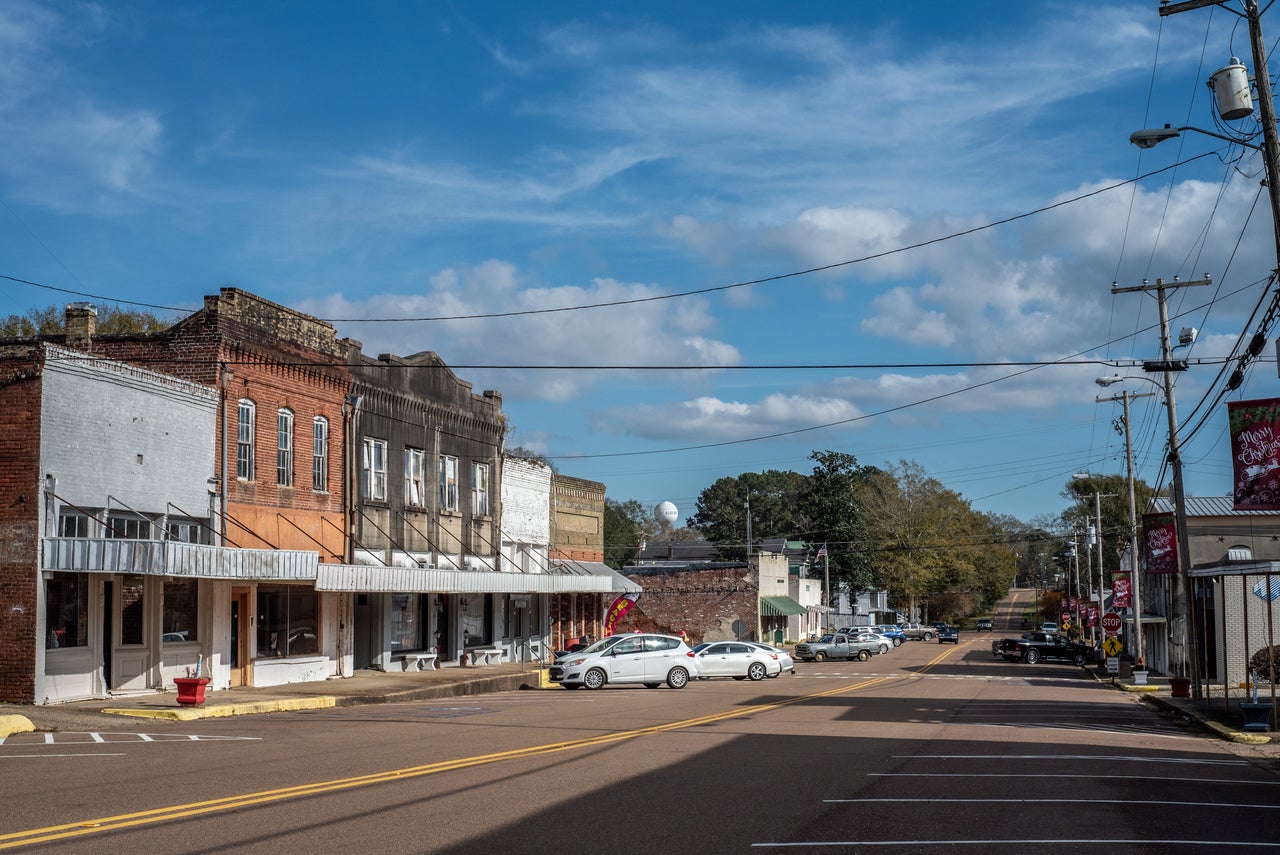
Bullish Or Bullshit On ‘Negative Emissions’
While U.S. exports of wood pellets have roughly doubled since 2014, the amount of electricity Americans generated from wood has fallen steadily since peaking that year. Today, biomass makes up just over 1% of U.S. electricity.
The largest wood-burning power plant in the U.S. opened in Gainesville, Florida, in 2013, and almost immediately caused a public scandal over costs. The deal to buy power from the 103-megawatt Deerhaven Renewable Generating Station proved so controversial — at roughly $70 million per year over three decades, electricity bills quickly rose – that the city spent $750 million to buy out the remainder of the contract.
In the U.K., by contrast, the 4,000-megawatt Drax Power Station — a massive coal- and wood-burning complex in northeastern England — supplies about 7% of the U.K.’s electricity with millions of tons of wood, much of which comes from forests in the American South.
This week, Drax unveiled plans to spend over $53 million to start work on new carbon capture machines that the company said will catch and store 8 million metric tons of CO2 per year. Already, the company calls its plant the “largest decarbonization project in Europe” because it had swapped much of its coal-fired production for wood.
The investment news came just a few months after Drax announced a deal with the U.S. engineering firm Bechtel on projects that would equip wood-burning power plants across North America with carbon capture technology.
Will Gardiner, Drax’s chief executive, said the deals demonstrate “Drax’s commitment to deliver a vital technology which is urgently needed to address the climate crisis.”
“It’s no longer enough to reduce emissions,” he said in a statement. “The world has got to start removing carbon from the atmosphere if we are to avert this climate crisis.”
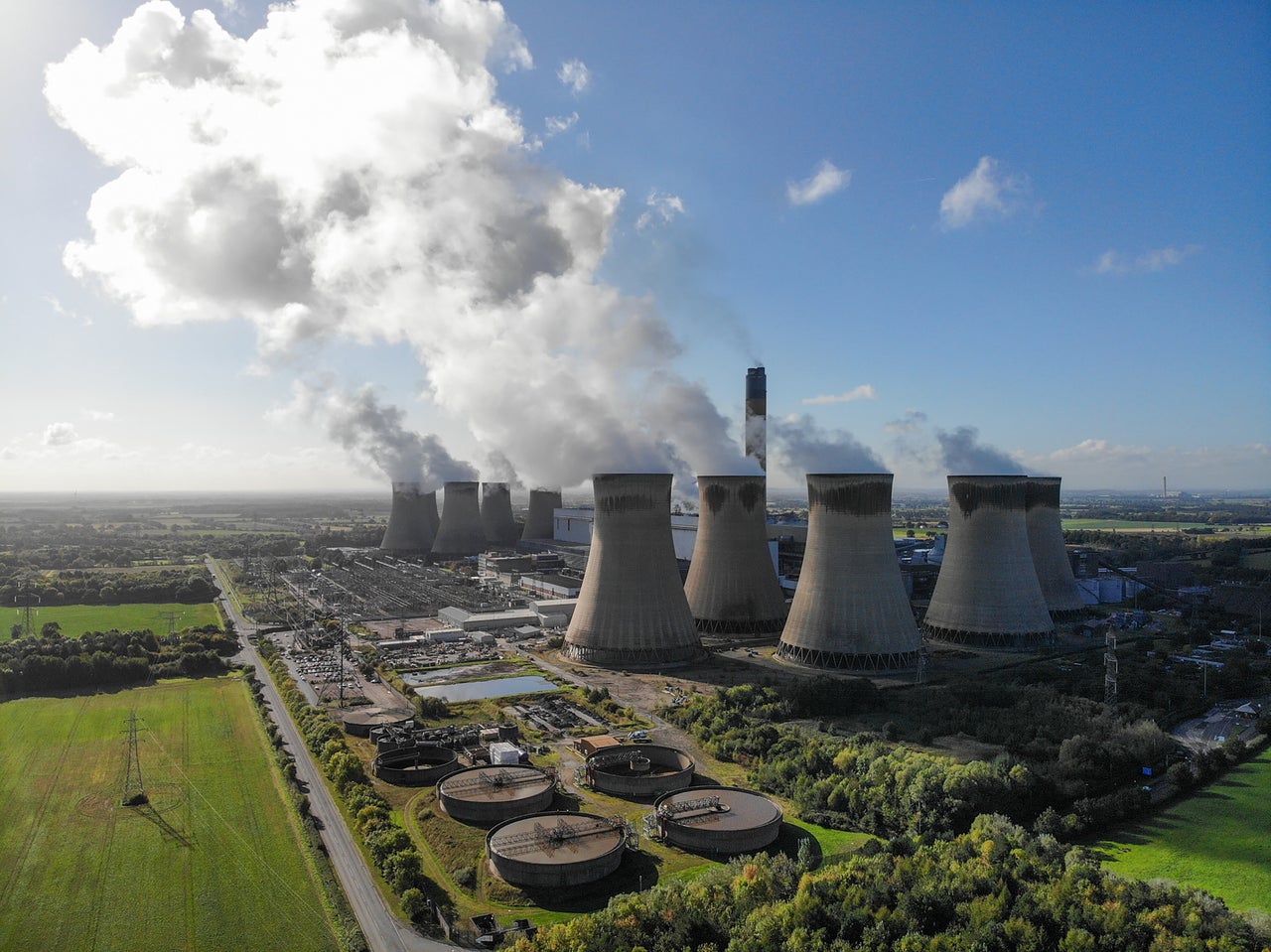
Since trees suck up huge amounts of carbon naturally, Drax and others in the industry say that equipping their plants with technology to capture carbon dioxide from smokestacks and store it underground will make biomass power a potential source of negative emissions. As governments set net-zero targets — points at which the amount of carbon their countries absorb equals or exceeds the CO2 they emit — demand for quantifiable ways to pull carbon from the atmosphere is growing.
But the U.N.’s IPCC itself acknowledged in its most recent report that the concept of bioenergy with carbon capture “rests on the premise that bioenergy production is carbon neutral.”
That, Booth said, renders Drax’s claims “bogus.”
“Burning trees and using CCS can no more deliver negative emissions than burning trees without CCS can deliver carbon-neutral emissions,” she said. “It’s the same problem. Trees don’t grow back that quickly.”
Drax’s negative-emissions effort may instead be a play for more subsidies. In a recent blog post, the Forest Defenders Alliance, a European environmental group, noted that Drax’s existing subsidies — totaling nearly $2.7 million per day — are set to phase out in five years. So the company, the post stated, is looking for a new “expensive scam” to get “more money out of the public.”
A report Drax commissioned and published in March proposes that the U.K. government continue providing subsidies both for power generation and carbon capture after 2027.

There are other issues to relying on wood energy at scale. If the world were to supply just another 2% of its electricity demand with wood, it would require doubling the annual harvest of wood, according to Timothy Searchinger, a senior researcher at Princeton University. Providing 3.5% of America’s energy demand would require doubling the number of trees cut down.
Other ways to provide negative emissions, such as direct air capture technology or soil management techniques, wouldn’t require felling forests that are actively sucking carbon as it is. Searchinger compared the proposition to exercise.
“If you eat lots of sugar but work out, you could be reasonably healthy,” he said. “But if you don’t eat lots of sugar and work out, you’ll be healthier.”
If the cost of capturing carbon with technology comes down, he said, you’d be better off burning coal or gas at a power plant than wood, since then you’d get a lot more energy per unit anyway.
Investors seem to be doubting Drax’s claims, too. In October, the S&P dropped the company from its Global Clean Energy Index. This month, Citi downgraded its stock from “buy” to “hold.”
There are some potential places where limited biomass energy could be useful, such as in California, where dead trees in drought-stricken forests need to be cleared anyway to reduce the harmful effects of wildfires, said Holly Jean Buck, a researcher at the University at Buffalo who studies negative emissions and decarbonization.
“The best case for biomass is waste biomass,” Buck said. “We should think more about using waste biomass streams and less about for-purpose crops that could be used for other things, whether those be lumber to build houses or land that could be dedicated to other things.”
(Drax, for its part, said about 40% of its wood does come from sawmill waste, citing data in its own annual report, and insisted the rest of its wood comes from trees that are “not suitable for other uses.”)
Searchinger said the biomass industry’s tree plantations could only contribute to a negative emissions target if the world was actively reducing the amount of land used for agriculture. Instead, in most countries, old-growth woodlands such as the Amazon or Borneo’s rainforests are being felled to make way for cattle ranches and palm oil plantations.
“The only way biomass becomes a potentially [carbon] negative contribution is in a world where we are actively reducing agricultural land and you have a choice as to whether you reforest that land or plant fast-growing woody plantations,” he said. “It’s entirely speculative, but depending on the assumptions you make, you could arguably get more benefit from the fast-growing biomass plantations.”
He added: “There are these theoretical scenarios in which maybe this could be useful, but they’re sufficiently far in the future that they’re irrelevant right now.”
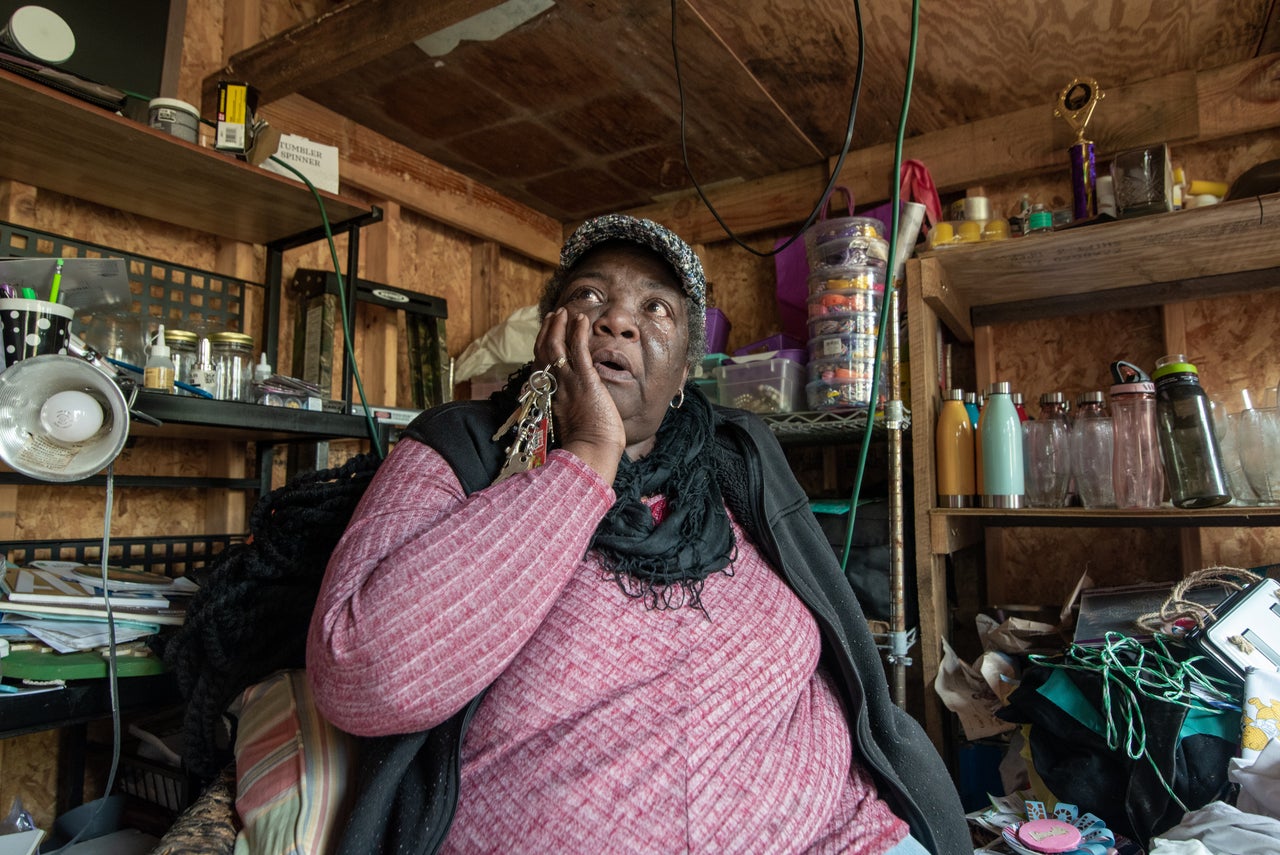
The biomass industry is set to experience its fastest growth in East Asia during the second half of this decade. A report published last year found South Korea was so heavily subsidizing biomass plants that the industry was crowding wind and solar out of the power market. Japan, meanwhile, is pushing ahead with plans to burn residues from palm oil for electricity, threatening even further deforestation.
In a February 2021 letter addressed to Biden, European, British, Japanese and Korean leaders, more than 500 scientists urged them “not to undermine both climate goals and the world’s biodiversity by shifting from burning fossil fuels to burning trees” and to “end subsidies and other incentives that today exist for the burning of wood.”
“Trees are more valuable alive than dead both for climate and for biodiversity,” the letter read. “To meet future net zero emission goals, your governments should work to preserve and restore forests and not to burn them.”
Wren-Causey feels like she can relate.
“I want to live,” she said.
And she has much to live for. She has her husband and young nieces she adores. She cares for an abandoned pony. She’s hoping to start a charity to help local kids, and once a week, she takes elderly women who can’t drive to the post office and bank.
“But every night I’m in bed,” she said. “I’m praying and asking God to please let me wake up in the morning.”
